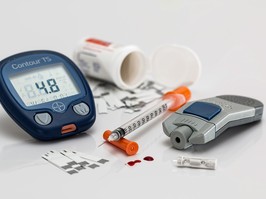food insecurity and diabetes: how a lack of nutritious food can affect your health
people living with diabetes may be more likely than other canadians to experience food insecurity because of added health-care expenses

if you live with type 1 or type 2 diabetes, you probably already know that eating healthy meals can help manage your blood sugar levels and weight, while also reducing the risk of diabetes-related complications such as heart attack and stroke. a well-balanced, nutritious diet can also help prevent the development of type 2 diabetes. yet many canadians cannot regularly get enough nutritious food for their overall health and well-being (a situation known as “food insecurity”). people living with diabetes may be more likely than other canadians to experience food insecurity because of added health-care expenses — for medications, devices, and supplies—which competes with the need to buy healthy food. in order to save money, they also put off filling prescriptions, reuse needles, and check their blood sugar less often than recommended.
rates of food insecurity vary across the country. according to statistics canada, the lowest rates of household food insecurity in 2011/12 (the most recent information available) were in manitoba and newfoundland, while the highest rates were in the northwest territories and nunavut.
indigenous canadians have high rates of food insecurity. “canada’s colonial policies and practices— including residential schooling, loss of culture, marginalization, relocation to remote northern regions, and unsettled land claims—have impacted food insecurity by severely limiting access to traditional diets,” says banasiak. “among other social and environmental considerations, these have contributed to rates of diabetes that are three to five times higher for indigenous canadians than the non-indigenous population.”
advertisement
[pn-pullquote text=”we often think that people choose what foods they want to eat on any given day. however, not everyone has access to the same choices. people with fewer resources struggle to access healthy food. this is one reason that diabetes disproportionately affects individuals living with lower income” source=”krista banasiak, research and public policy manager, diabetes canada”/]
how limited food choices affect blood sugar levels
bonita nowe-matheson regularly sees clients who struggle to eat healthy food. as a diabetes outreach dietitian with the saint john region horizon health network in new brunswick, she also sees how food insecurity affects their diabetes management.
bonita nowe-matheson regularly sees clients who struggle to eat healthy food. as a diabetes outreach dietitian with the saint john region horizon health network in new brunswick, she also sees how food insecurity affects their diabetes management.
“the foods that we recommend for good diabetes management—whole foods, higher-fibre, lower-sodium foods—cost more. when people lack money, their food choices are limited,” she says.
when budgets are tight, people tend to eat fewer fruits and vegetables because they cost more than foods that are high in calories but low in nutrition. that could mean buying cheaper white bread instead of whole-wheat pita, which will cause blood sugar levels to rise.
[pn-pullquote text=”many of my clients often have to decide between buying medication or food; between using bus fare to go to a medical appointment or to the grocery store. this isn’t an issue of budgeting. there simply is no money.” source=”bonita nowe-matheson, registered dietitian ” /]
advertisement
when they cannot afford to buy enough food, some people may even skip meals, causing their blood sugar levels to drop. nowe-matheson says many of her clients are more likely to experience hypoglycemia (dangerously low blood sugar) toward the end of the month, as their money and food run low. “it is hard for people to reach their blood sugar targets if they don’t have regular access to healthy foods. over the long term, they are at risk of developing diabetes-related complications earlier,” she says.
why food banks are not the answer
food banks are vital for people on low incomes, but they are often limited in their ability to serve clients with special health needs, such as those with diabetes. many food banks do not have refrigerators, and so they rely largely on donations of food that will last longer and does not need to be refrigerated—meaning food that is packaged and non-perishable rather than fresh fruits and vegetables, dairy, or meat.
food banks are vital for people on low incomes, but they are often limited in their ability to serve clients with special health needs, such as those with diabetes. many food banks do not have refrigerators, and so they rely largely on donations of food that will last longer and does not need to be refrigerated—meaning food that is packaged and non-perishable rather than fresh fruits and vegetables, dairy, or meat.
this creates a problem for marleane davidson, which she faces every two weeks when she gets a package of food from a toronto food bank. davidson, 53, has type 2 diabetes, high blood pressure, celiac disease (a digestive disorder in which the body cannot handle gluten, a protein found in wheat and many packaged foods), and other food allergies. she is unable to work due to degenerative spine disease, and she struggles to cover her rent and other bills with the limited money she receives from the ontario disability support program (odsp). she needs the food bank to stretch the few groceries she can afford, but she is dismayed by the quality of the food.
advertisement
[pn-pullquote text=”i’ve had to skip meals, sometimes eating only once a day. i’ve passed out in the street because my blood sugar was so low.” source=”marleane davidson, person living with type 2 diabetes” /]
“there are hardly any vegetables or fruits. most of the food is processed and really high in salt, which i shouldn’t have because of my blood pressure,” davidson says. recent packages have included a bag of sugar, candies, and cocoa puffs cereal.
davidson would like to see dietitians work with food banks to ensure their offerings follow canada’s food guide and meet the nutritional and health needs of their clients. she notes that some food banks now offer their clients gift cards for local grocery stores, allowing them to choose the food that best suits their needs. “just because there are food banks, that doesn’t mean everyone can get the food they need. for me and so many people like me, it is an everyday challenge to get something appropriate to eat.”
—
addressing a public health issue
diabetes canada recently issued a policy statement about food security, which says all canadians should have access to affordable, culturally appropriate, sufficient, safe, and nutritious food.
advertisement
diabetes canada recommends that the federal government:
- invest in social policies aimed at expanding access to employment, housing, and food for people living in poverty so that they will have sufficient income to provide for their nutrition needs
- develop price policies to help make healthy foods more affordable, such as vouchers for fresh fruits and vegetables, or subsidizing fresh fruits and vegetables so they are cheaper than carbohydrate-laden, nutrient-poor food
- work to improve the nutrition north program to increase the availability of affordably priced foods in canada’s remote northern regions
stretching limited resources
registered dietitian bonita nowe-matheson offers advice to people living with diabetes and food insecurity:
– do not be embarrassed to talk with your health-care provider about your concerns regarding food security. they may be able to connect you with helpful resources in your community.
advertisement
– ask your health-care provider to refer you to a social worker. social workers usually have the most up-to-date information about government assistance programs.
– ask your diabetes care professionals to show you how to adjust your insulin or diabetes medication for different times of the day or month when you have less food.
– try to eat a meal or snack three times a day. if all you can afford is a box of mac and cheese, it is better to divide it into three portions spread throughout the day. eating it all at once will cause your blood sugar to rise.
– drink water instead of pop, juice, or coffee—it is not only healthier, but cheaper, too.
– try to eat from at least three food groups each day. to balance your blood sugar between meals, include lower-cost protein such as eggs, peanut butter, lentils, or beans.
– add one additional serving of fruit a day. if you are currently eating none, add one; if you are eating one, try to eat two.
– buy frozen or canned fruits and vegetables, which are often cheaper but just as nutritious as fresh. drain and rinse canned foods to remove some of the salt.
—
diabetes 360° is a nation-wide strategy that aims to ensure 90 per cent of canadians will experience improved health outcomes and more. get more information and email your candidate now.
advertisement
how can you help us fund research, projects, and campaigns that change lives? donate now!
this article appeared in diabetes dialogue.
disclaimer: this section has been written/provided by diabetes canada with the goal of educating canadians. the content on the website is intended for educational and informational purposes only. the content is not intended to provide medical advice and, to the extent that medical advice is required, users should consult with qualified medical professionals.
 6 minute read
6 minute read





